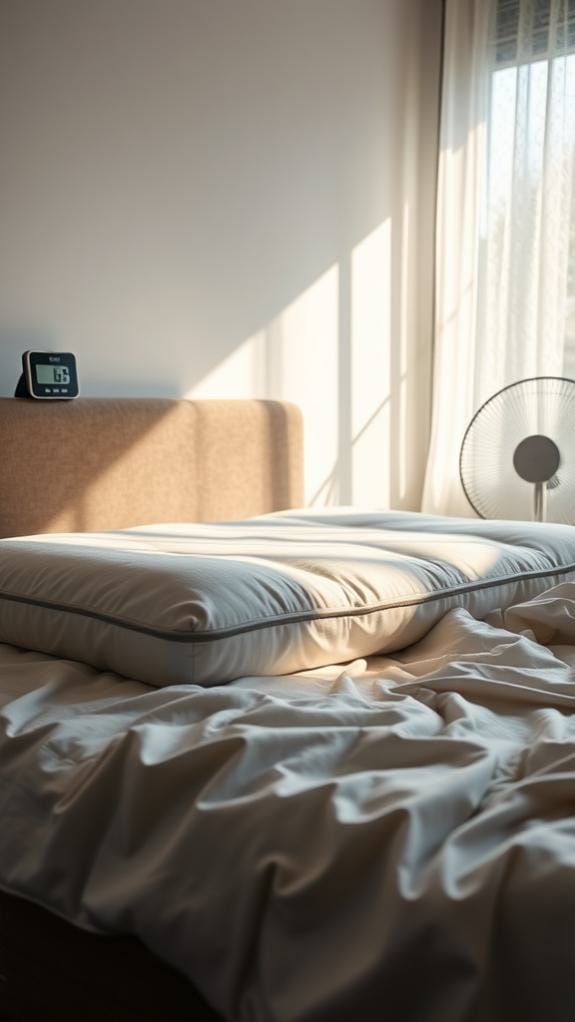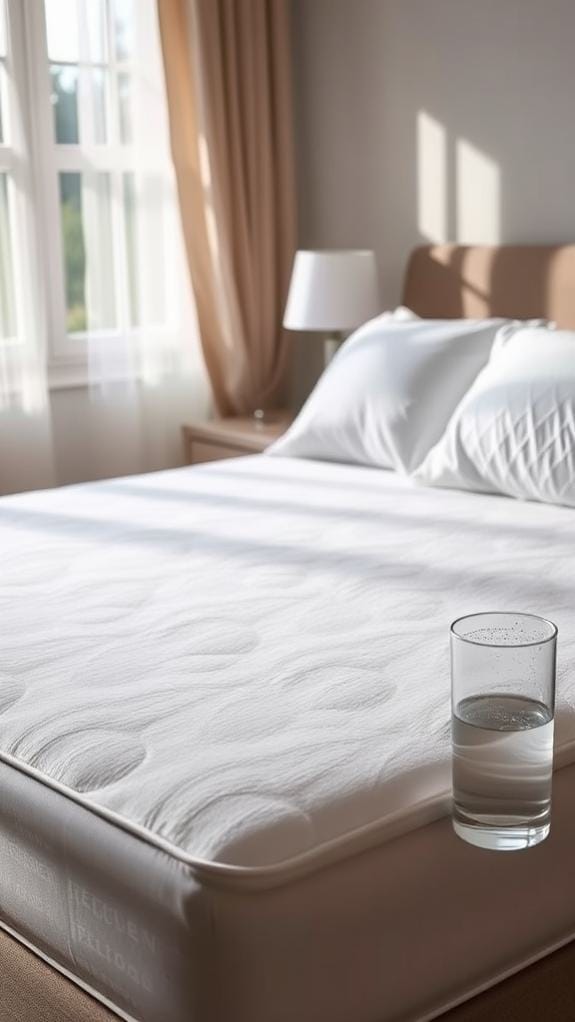Can Mattress Toppers Cause Night Sweats? The Truth
Have you ever wondered if your mattress topper is making your night sweats worse? It might sound strange, but the materials used in these toppers can seriously affect your sleep quality.
For example, synthetic foams are notorious for trapping heat. On the other hand, some materials are designed to promote airflow, keeping you cooler at night.
So, how do you pick the right one? Let’s break down the different materials and what you should consider to ensure a more comfortable night’s sleep.
Understanding Night Sweats

Comprehending night sweats can be quite essential for anyone experiencing them. I remember the first time I was jolted awake, drenched in sweat. It’s not just uncomfortable; it can be alarming, too.
Night sweats can stem from various causes, like menopause symptoms, anxiety, or even certain medications. If you’re on antidepressants or painkillers, they might be the culprit. Additionally, hormonal disorders such as an overactive thyroid can also contribute to night sweats.
Lifestyle choices play a role, too. I found that my heavy bedding and warm room made things worse.
If you’re struggling with night sweats, it’s important to monitor when they happen and consider these factors.
If it’s a regular issue, or if you notice other symptoms, don’t hesitate to seek medical advice. You deserve restful nights!
Materials That Affect Temperature

Grasping how different materials affect temperature can greatly improve your sleep quality, especially if you experience night sweats.
I’ve found that synthetic foams, like memory foam, can really trap heat. They mold to your body but limit airflow, making it tough to regulate temperature. Trust me, I’ve woken up sweaty more than once! In fact, many brands use misleading marketing terms that claim to offer cooling properties without truly delivering. This is particularly concerning because heat retention can significantly impact your comfort during sleep.
Then there are those cheap plastic mattress protectors. They block airflow and trap moisture, which doesn’t help with cooling.
Heavy bedding, like down comforters, can also be a culprit. I’ve swapped out my polyester sheets for breathable cotton ones, and it made a big difference.
Lastly, be cautious with non-breathable mattress toppers; they can exacerbate sweating. It’s all about choosing the right materials to keep cool at night!
Cooling Mattress Topper Options

Finding the right mattress topper can make a significant difference in managing night sweats and overall sleep comfort.
I’ve tried a few options that really stand out.
The Helix GlacioTex Premium Mattress Topper is fantastic. Its cooling cover and hybrid design help regulate temperature while providing great support, especially if you deal with back pain. This topper features high-density foam and steel microcoils to enhance pressure relief, while the open-cell construction allows for better airflow, reducing heat retention.
I also enjoyed Saatva’s Cooling Graphite Mattress Topper. It effectively pulls heat away without that chemical smell, and it fits snugly on the bed.
For a touch of luxury, the Tempur Adapt is worth considering. Its cool-to-the-touch feel and machine-washable cover add convenience.
Whichever you choose, a cooling mattress topper can be a transformative element for comfortable sleep!
Breathability of Mattress Protectors
Regarding a good night’s sleep, breathability in mattress protectors plays an essential role.
I’ve learned that choosing the right materials can make a big difference in how comfortably you sleep. Here are some features I recommend looking for:
- Natural fibers: Cotton, bamboo, and Tencel are great for moisture-wicking and cooling.
- Breathable membranes: These allow airflow while keeping liquids out.
- Lightweight designs: Fitted pads can improve breathability without adding bulk.
- Certifications: Look for GOTS-certified organic cotton for peace of mind and breathability. Additionally, materials like wool are known for their temperature regulation properties, which can enhance overall sleep comfort.
When I switched to a breathable protector, I noticed fewer night sweats and a much more comfortable sleep. With a water-resistant layer made of polyurethane, you can enjoy both protection and comfort.
Trust me, it’s worth the investment!
Impact of Room Environment

Creating a comfortable sleep environment is essential for managing night sweats effectively. I’ve found that keeping my bedroom temperature between 60 and 68 degrees Fahrenheit works wonders. When it’s too warm, my body tends to sweat to cool down, which is uncomfortable. Additionally, excessive bedding can trap heat and exacerbate sweating, so it’s important to find the right balance. It’s also beneficial to consider ventilated designs in mattress toppers that promote airflow and reduce heat retention.
I also noticed that my bedding plays a huge role. Thicker fabrics and heavy blankets can trap heat, making those night sweats even worse. Switching to breathable materials, like percale cotton sheets, has made a big difference for me.
I’ve started using a small digital thermostat to monitor the temperature, and it’s been a game changer.
Additionally, I recommend wearing loose, breathable clothing to bed. These little tweaks can greatly improve your sleep quality and help you stay cool.
Role of Mattress Protectors

A good mattress protector can make all the difference regarding managing night sweats.
I’ve learned that the right materials can really regulate my sleeping temperature and keep me dry.
Here’s what I recommend looking for in a protector:
- Breathable fabrics: Go for cotton, Tencel, or bamboo to promote airflow.
- Moisture-wicking properties: Tencel’s absorbency is a significant factor for keeping sweat at bay.
- Cooling technology: Some protectors create a cooler sensation, enhancing comfort.
- Avoid synthetics: Stay clear of plastic or vinyl, as they trap heat and moisture.
Additionally, look for a protector that provides a waterproof layer while allowing air circulation to further enhance your sleep experience.
Additional Tips for Comfort

Finding the right combination of mattress toppers and bedding can drastically improve your comfort during the night. Trust me, it makes a world of difference! Here are some tips that have worked wonders for me:
| Material Type | Benefits | Recommendations |
|---|---|---|
| Organic Latex | Naturally cooling | Turmerry Latex Mattress Topper |
| Gel Memory Foam | Temperature-regulating | Ghostbed Memory Foam Topper |
| Breathable Fabrics | Regulates surface temperatures | Bamboo rayon sheets |
I’ve found that switching to breathable sheets and using a cooling mattress pad really helps. Additionally, using a cooling mattress topper can significantly enhance sleep quality by maintaining optimal temperature throughout the night. And remember, keeping your bedroom cool with a fan or AC is key! These small adjustments can lead to a more restful, sweat-free sleep.
Frequently Asked Questions
Can Night Sweats Be a Sign of a Medical Condition?
Definitely! Night sweats can indicate different health issues, like hormonal shifts, infections, or side effects from meds. If you’re dealing with this, it’s a good idea to chat with a doctor to get some clarity and peace of mind. Take care of yourself!
How Often Should I Replace My Mattress Topper?
I swap out my mattress topper every 3 to 5 years, even if it still feels okay. I pay attention to how my body feels and look for any wear and tear. Trust me, it makes a huge difference for a good night’s sleep! Keep your comfort in check!
Do Mattress Toppers Affect Sleep Quality?
Absolutely! Mattress toppers can really boost your sleep quality. They add comfort, support where you need it, and help with temperature control. Just make sure to pick the right material to avoid getting too hot at night. It’s all about finding what works best for you!
Can Sleep Position Influence Night Sweats?
Absolutely, sleep position can impact night sweats! I’ve found that sleeping on my side makes me feel warmer, while back sleeping helps with airflow. It’s interesting how different positions can affect comfort and heat distribution. Give it a try and see what works best for you!
Are There Specific Brands Known for Cooling Mattress Toppers?
If you’re looking for cooling mattress toppers, I recommend checking out Nolah, Helix, and Saatva. They use awesome materials like gel and graphite that really help keep you comfy and cool all night long. Trust me, you won’t regret it!
In Conclusion
Can mattress toppers cause night sweats? Yes, they can—especially if you go for materials like thick memory foam. I’ve experienced that discomfort firsthand, waking up feeling drenched.
Switching to a breathable latex or gel-infused topper was a game-changer for me. It really made a difference in my sleep quality!
Also, remember to consider your room’s temperature and humidity. With the right choices, you can enjoy cozy, sweat-free nights.
Trust me, it’s totally worth the effort for a better night’s sleep!
